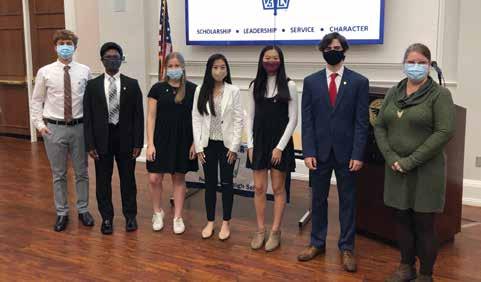
4 minute read
Virtual 101
Virtual 101 Tutoring services adjust to pandemic
By Brandon Klein
Over the last few years, the New Albany High School’s National Honor Society chapter tutoring services have evolved with the addition of a tutoring center and a secretary position to run it.
This year, the tutoring services really had to evolve. In response to the pandemic, tutoring has gone virtual.
In previous semesters, NHS members tutored 30 to 50 students on a regular basis. Sessions normally lasted 30 minutes to an hour before and after school. Those sessions are now held on video chat applications to maintain social distancing.
“It’s the same process but we just

moved it to Google Meet,” says Kaan Odabas, an NAHS senior and secretary of the NHS’s tutoring center.
NAHS began offering its services in late October to give the student body time to adjust to the new learning environment that consists of inperson and virtual instruction. “Some people may not realize they may need help until a few more weeks,” Photo Courtesy of NAPLS Odabas says. Kaan Odabas
With virtual tutoring, Odabas says more coordination is involved, which includes staying on top of emails from tutors and the students they are tutoring. He strives to pair students based not only on their curriculum track, but also if they opted to take virtual instruction. This was before NAHS switched back to a hybrid model in November.
“Kaan has done a great job of pairing them up,” says Jenny Core, NHS’ faculty adviser.
The NHS chapter wasn’t the only tutoring service forced to pivot. Other tutoring programs throughout the New Albany area and beyond had to adjust to the pandemic and the onset of virtual instruction. The Columbus Metropolitan Library’s New Albany Branch averaged about 30 students a day during its Homework Help Center hours prior to the pandemic-related shutdowns.
“We all had to make quick adjustments,” says Benjamin Reid, the New Albany branch manager.
In the spring, the CML offered homework help online chat sessions or a general phone line for students to ask tutors questions. The chat sessions offered oneon-one assistance to students, which wasn’t always available with the old Homework Help Center, but it was difficult for those students to show the homework problems they were working on.
During the summer, CML redesigned its Homework Help services. It expanded its website, and call or online chat discussions can lead to online video tutoring, Reid says. Those video chat sessions offer a shared virtual whiteboard that students can use to write out problems for the tutors to see.
While the old Homework Help Center’s hours were limited from 3 to 6 p.m. after school, the library’s expanded services online range from 9 a.m. to 7 p.m. Monday through Thursday, and 9 a.m. to 6 p.m. on Friday. The library also contracted online tutoring service Brainfuse to offer additional tutors from 2 to 11 p.m. Monday through Friday.


“We’ve innovated, we’ve learned a lot in some ways to better serve our customers,” Reid says.
The abrupt switch to virtual tutoring services perhaps posed greater challenges for Marburn Academy, which serves students with learning differences such as dyslexia.
Marburn Academy’s tutors use the Orton-Gillingham approach, which emphasizes multisensory teaching practices that use physical tools, such as flashcards, for students to interact with during their sessions with the tutor. Those tools are now mailed to the student, but online tutors have to con-

The New Albany High School’s National Honor Society chapter tutoring services have evolved with the addition of a tutoring center and a secretary position to run it. It now offers virtual tutoring services due to the pandemic.

tend with new kinds of distractions for the student.
“It’s tricky (to tutor) when a child is in their bedroom,” says Lisa Neuhoff, an Orton-Gillingham training fellow, now in her 27th year at Marburn.
She adds that the school’s technology team has provided new ideas to improve its online tutoring service.
“We’re staying on the cutting edge and becoming more efficient and better with each tool they give us,” she says.
While Marburn has allowed some in-person tutoring sessions, many tutors choose to continue to do so virtually.
Neuhoff says, however, virtual tutoring has provided an opportunity to expand its outreach. Marburn’s services, for instance, have been extended to students in Athens.
The reverse is also true. Coleman Fisher, a ninth-grader at Marburn, says his tutor is based in Lima. The initial virtual tutoring sessions were challenging, because of an internet connection issue. After it was resolved, Fisher says he preferred the experience over in-person instructions.
“I’m in an environment where I feel more comfortable,” Fisher says.
Brandon Klein is the editor. Feedback welcome at bklein@ cityscenemediagroup.com.










